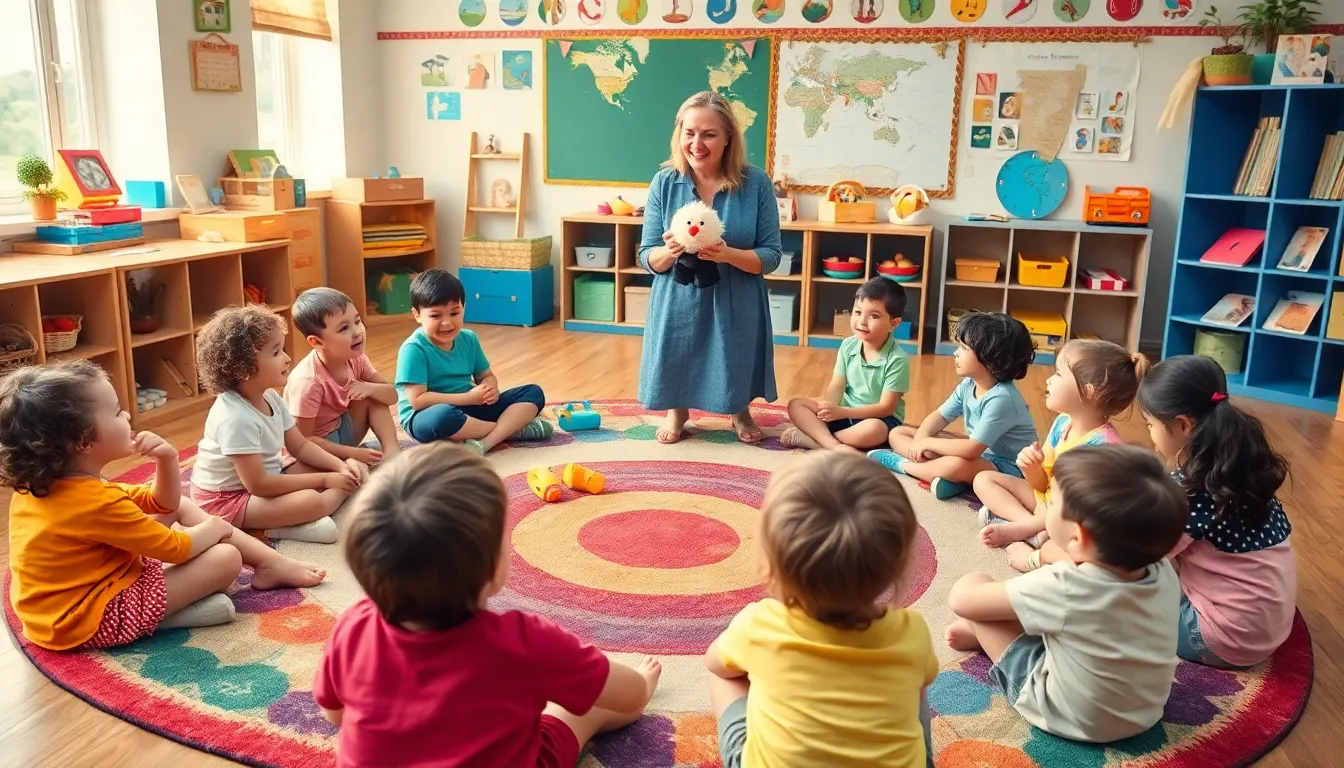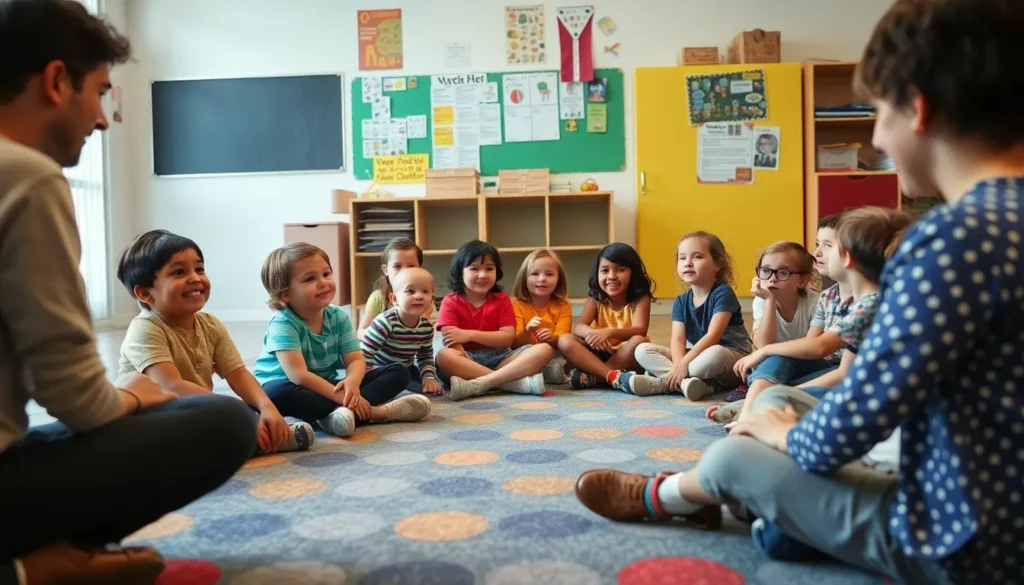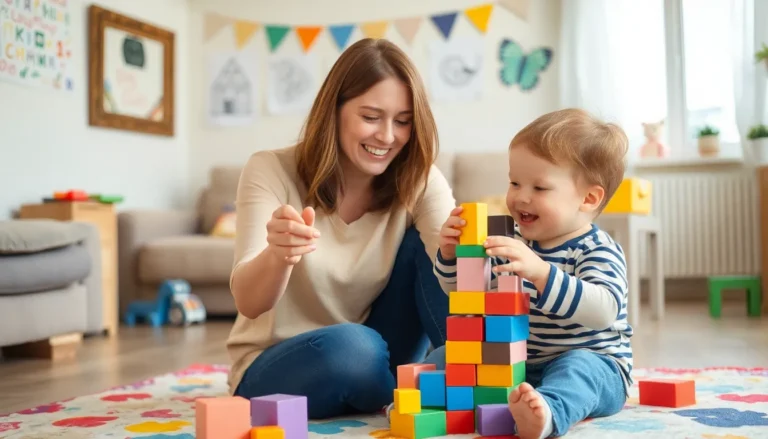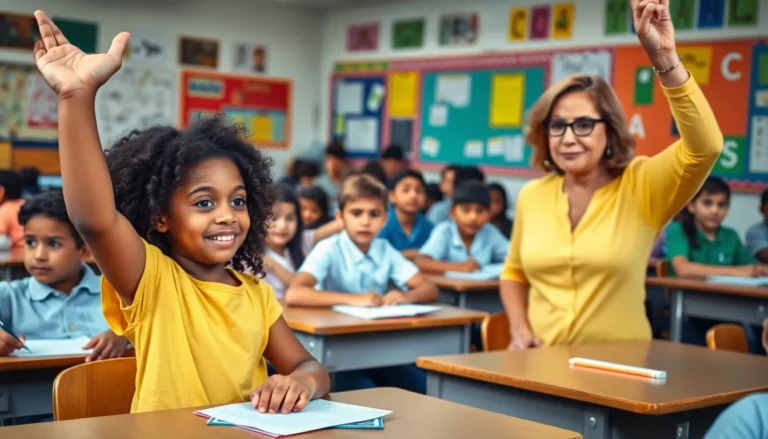Table of Contents
ToggleCircle time isn’t just for kids to sit in a cozy circle and share their favorite snack—it’s a magical moment where learning and laughter collide. Picture a room full of eager little faces, each one ready to embark on a journey of discovery. With the right circle time ideas, this daily ritual can transform into an unforgettable adventure that sparks curiosity and creativity.
What Is Circle Time?
Circle time serves as a structured activity that fosters communication and social skills among children. During this time, children gather in a circle to engage in discussions, share stories, and participate in various activities. It’s common for educators to lead these sessions, guiding children through the learning process.
Incorporating elements like songs and games makes circle time interactive. Engaging children in these activities promotes motor skills and creativity while enhancing cognitive development. The focus on group participation encourages children to express their thoughts and feelings in a supportive environment.
Circle time can vary in length, typically lasting from 15 to 30 minutes. The setting can include a variety of topics, such as daily routines, seasonal themes, or cultural celebrations. This flexibility allows for adaptation to meet the ongoing interests of the children involved.
Utilizing props and visual aids can enhance circle time’s effectiveness. Items like puppets or picture cards draw attention and spark imagination. It’s essential for educators to evaluate the children’s responses and adjust activities accordingly to maintain engagement.
Through the experience of circle time, children develop critical skills such as listening, turn-taking, and cooperation. These foundational abilities support their emotional and social growth, preparing them for future group interactions. Appreciating the value of circle time encourages educators to continually seek new and exciting activities for their students.
Benefits Of Circle Time

Circle time offers numerous benefits for children, playing a crucial role in their early development.
Social Skills Development
Social skills blossom during circle time. Children interact with peers, learning how to communicate effectively. Sharing stories fosters empathy and understanding, allowing them to relate to others’ feelings. Engaging in group activities encourages turn-taking and cooperation, essential elements for forming friendships. Children also practice active listening, further enhancing their social interactions. As they participate in discussions, they grow comfortable expressing their thoughts. Positive reinforcement from educators builds confidence, creating a supportive environment where children feel valued. Overall, circle time cultivates a sense of community among young learners.
Cognitive Growth
Cognitive growth occurs naturally through circle time experiences. Children explore new concepts while discussing varied topics, stimulating their curiosity. Engaging in songs and games enhances memory retention and boosts language skills. Visual aids, such as puppets or picture cards, support comprehension by providing concrete references. Activities included during this time encourage critical thinking and problem-solving abilities. Additionally, children strengthen their attention spans as they listen to others speak. The structured format of circle time aids in developing organization skills, essential for future academic success. All these elements combined create a rich environment for intellectual advancement.
Creative Circle Time Ideas
Circle time can transform into an engaging experience with creative activities designed for young learners.
Theme-Based Activities
Theme-based activities capture children’s interests and can encompass various topics. Educators might explore themes like animals, seasons, or community helpers. Incorporating visual aids such as themed props or picture cards enhances engagement. For instance, a nature theme could include discussions about trees, plants, and animals, accompanied by related songs and crafts. Children can even participate in role-playing or storytelling tied to the theme, fostering creativity. Adjusting activities to meet children’s interests ensures that circle time remains dynamic and relevant.
Interactive Storytelling
Interactive storytelling captivates children’s attention and encourages participation. Educators might select age-appropriate books and invite children to act out scenes. Using props enhances the storytelling experience, helping children visualize the narrative. Additionally, asking open-ended questions during the story prompts discussion and critical thinking. Children might share their thoughts on characters and plot twists, promoting communication skills. This activity not only nurtures a love for reading but also strengthens listening skills and comprehension, contributing to overall cognitive development.
Incorporating Movement
Incorporating movement in circle time enhances engagement and promotes physical development. Children benefit from activities that activate their bodies and minds.
Songs and Rhymes
Songs and rhymes introduce rhythm and movement. Incorporating clapping games or simple dance moves connects actions to lyrics, keeping children excited. Repetitive phrases encourage participation, making it easier for kids to remember lyrics and actions. Songs like “Head, Shoulders, Knees, and Toes” effectively combine movement with learning body parts, enhancing both language acquisition and motor skills. Rhymes often include actions that mirror the words, reinforcing memory and comprehension. This approach not only captivates attention but also fosters an energetic atmosphere during circle time.
Games and Exercises
Games and exercises promote physical activity while reinforcing social skills. Incorporating simple games like “Simon Says” encourages listening and following directions. These activities often invite laughter, creating a joyful learning environment. Different exercises like stretching or yoga poses can enhance flexibility while calming children. Utilizing movement-based games fosters teamwork and collaboration, essential elements in social interactions. Integrating physical challenges, such as obstacle courses, allows children to explore their capabilities while building confidence and improving coordination.
Tips For Effective Circle Time
Effective circle time relies on strategies that promote inclusivity and adaptability. Engaging every participant enhances the experience for everyone involved.
Engaging All Participants
Incorporating hands-on activities captivates children’s interest. Utilizing interactive games encourages participation and fosters enthusiasm. Offering varied roles during circle time helps children feel valued, as everyone can contribute. Singing songs with motions involves the whole group, allowing children to express themselves. Engaging all participants nurtures collaboration and promotes excitement, making circle time a memorable event. Adapting activities based on observations keeps engagement high and ensures everyone is involved.
Managing Different Age Groups
Adjustments in activities accommodate diverse age ranges effectively. Tailoring discussions to match developmental stages supports understanding for younger participants while still challenging older ones. Shortened activities work better for younger children to maintain focus. Including roles that allow older children to assist or lead encourages responsibility and leadership. Using a mix of visual aids and verbal instructions caters to various learning styles and enhances comprehension. Through careful planning, circle time becomes enjoyable and beneficial for all age groups present.
Circle time is a powerful tool for fostering children’s growth in both social and cognitive areas. By creating an engaging and interactive environment, educators can help children develop essential skills while having fun. Incorporating diverse activities and themes keeps circle time fresh and relevant, ensuring that children remain excited and eager to participate.
As educators embrace the value of circle time, they can continually innovate to meet the needs of their students. This adaptability not only enhances the learning experience but also nurtures a sense of community among young learners. Ultimately, circle time is more than just a routine; it’s an opportunity for discovery and connection that lays the foundation for lifelong learning.







